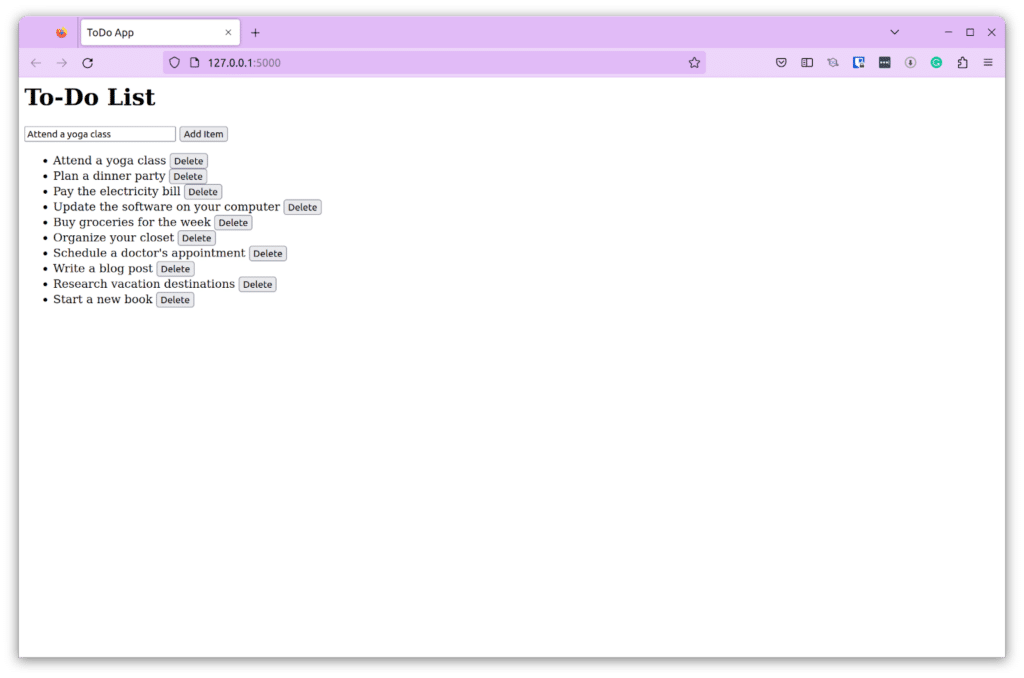Monitoring software applications and infrastructure can be a daunting task, especially during periods of increased usage. Recently, an e-commerce company was gearing up for an upcoming festive season, and their on-premises application’s critical component was the order management system. The system was responsible for handling a sudden influx of orders during the festive sales.
However, the team noticed that the application was struggling to handle the sudden spike in traffic and was frequently down, causing frustration among customers and resulting in a loss of revenue for the business owners.
Upon investigating, the IT team found that their existing monitoring system was not up to the task, prompting them to work on an alternate monitoring solution.
In this blog post, we’ll replicate the prototype the team proposed, showcasing how they built a robust monitoring pipeline using Fluent Bit, Prometheus, and an observability platform.
ToDo Prototype
To substitute for the ordering system, we’ll be using a simple ToDo application written in Python using Flask. The application runs on an Ubuntu machine which has Fluent Bit running as a service. Fluent Bit’s Prometheus scrape input plugin is used and the output is Prometheus remote write.
To add custom metrics to this application, we’ll use Prometheus’s Python SDK. Custom metrics like request count and time are added to the application. The Prometheus SDK also configures a metrics endpoint where the metrics will be pushed. These metrics are then pushed to the Prometheus-compatible endpoint using Fluent Bit’s Prometheus remote write plugin for visualization.
Prerequisites
To follow along with our demonstration, you’ll need the following:
- Fluent Bit For Ubuntu – you can choose a different version based on your environment.
- Prometheus Python SDK
- Redis Server – the ToDo application uses Redis to store the ToDo items
- A Prometheus-compatible endpoint for visualization
Set up the ToDo application
Start by cloning the GitHub repo containing the ToDo apo and setting up the application on your server.
Let’s look into the sample ToDo application to understand what it does.
Import prometheus_client and Redis. Also, configure it to connect to the Redis server at the specific host and port.
from prometheus_client import Summary, make_wsgi_app, Gauge
from redis import Redis
redis = Redis(host='localhost', port=7777, db=0)Create the Prometheus metrics. If you would like to learn more about the various types of Prometheus metrics, read “An introduction to the 4 primary types of Prometheus metrics.“
REQUEST_TIME_LIST = Summary('request_time_list', 'Time spent for LIST request')
REQUEST_TIME_ADD = Summary('request_time_add', 'Time spent for ADD request')
REQUEST_TIME_REMOVE = Summary('request_time_remove', 'Time spent for DELETE request')
REQUEST_ADD_COUNT = Gauge('request_add_count', ' No. of Requests to add items')
REQUEST_REMOVE_COUNT = Gauge('request_remove_count', 'No. of Requests to remove items')Decorate a function with the Prometheus metric and add them wherever necessary.
@REQUEST_TIME_ADD.time()
@app.route('/add', methods=['POST'])
def add_todo_item():
item = request.json['item']
redis.set(item, item)
REQUEST_ADD_COUNT.inc()
return jsonify({'success': True})Lastly, you need to configure the metrics endpoint; this way you can access the metrics at http://127.0.0.1:5000/metrics.
app.wsgi_app = DispatcherMiddleware(app.wsgi_app, {
'/metrics': make_wsgi_app()
})Run the application and access it athttp://127.0.0.1:5000. Make sure to run your redis-server on port 7777 as configured in the application.

Fluent Bit Configuration
Since this application is running on Ubuntu, we have configured Fluent Bit to run as a service. The next step is to configure the INPUT and OUTPUT plugins in the Fluent Bit configuration file. On Ubuntu, you can find it under /etc/fluent-bit/.
As mentioned earlier, we’ll use prometheus_scrape INPUT plugin to collect metrics from our ToDo application. As for the OUTPUT plugin, we use promethus_remote_write to send the metrics to the Prometheus-compatible endpoint for visualization.
[INPUT]
name prometheus_scrape
host 127.0.0.1
port 5000
tag todo_app
metrics_path /metrics
scrape_interval 2s
[OUTPUT]
name stdout
match *
[OUTPUT]
Name prometheus_remote_write
Match *
Host metric-api.newrelic.com
Port 443
Uri /prometheus/v1/write?prometheus_server=todo-app
Header Authorization Bearer
Log_response_payload True
Tls On
Tls.verify OnAfter you have the configurations done, you can restart the fluent-bit service:
sudo systemctl restart fluent-bit
sudo systemctl status fluent-bit
● fluent-bit.service - Fluent Bit
Loaded: loaded (/lib/systemd/system/fluent-bit.service; disabled; vendor preset: enabled)
Active: active (running) since Thu 2023-04-06 12:17:17 IST; 1min 15s ago
Docs: https://docs.fluentbit.io/manual/
Main PID: 70474 (fluent-bit)
Tasks: 6 (limit: 17681)
Memory: 12.7M
CPU: 60ms
CGroup: /system.slice/fluent-bit.service
└─70474 /opt/fluent-bit/bin/fluent-bit -c //etc/fluent-bit/fluent-bit.conf
Apr 06 12:18:31 my-user fluent-bit[70474]: 2023-04-06T06:48:30.947820484Z process_max_fds = 1048576
Apr 06 12:18:31 my-user fluent-bit[70474]: 2023-04-06T06:48:30.947820484Z request_time_list_created = 1680763430.1415606
Apr 06 12:18:31 my-user fluent-bit[70474]: 2023-04-06T06:48:30.947820484Z request_time_add_created = 1680763430.1416097
Apr 06 12:18:31 my-user fluent-bit[70474]: 2023-04-06T06:48:30.947820484Z request_time_remove_created = 1680763430.141633
Apr 06 12:18:31 my-user fluent-bit[70474]: 2023-04-06T06:48:30.947820484Z request_add_count = 10
Apr 06 12:18:31 my-user fluent-bit[70474]: 2023-04-06T06:48:30.947820484Z request_remove_count = 1
Apr 06 12:18:31 my-user fluent-bit[70474]: 2023-04-06T06:48:30.947820484Z request_time_list = { quantiles = { }, sum=0, count=0 }
Apr 06 12:18:31 my-user fluent-bit[70474]: 2023-04-06T06:48:30.947820484Z request_time_add = { quantiles = { }, sum=0, count=0 }
Apr 06 12:18:31 my-user fluent-bit[70474]: 2023-04-06T06:48:30.947820484Z request_time_remove = { quantiles = { }, sum=0, count=0 }
Apr 06 12:18:32 my-user fluent-bit[70474]: [2023/04/06 12:18:32] [error] [input:prometheus_scrape:prometheus_scrape.0] empty responseNote: If Fluent Bit is configured to utilize its optional Hot Reload feature, you do not have to restart the service.
At this point, your application is running, it’s generating metrics which is pushed to the
Visualize your metrics
The final step is to visualize your metics using the tool or platform of your choice. This could be a simple visualization tool like Grafana or a complete platform like New Relic or Chronosphere Platform.
This is how, by leveraging the power of Fluent Bit, Prometheus, and an observability platform, the team was able to build a robust monitoring pipeline that helped them collect metrics for their application and infrastructure.
Manage your pipelines at scale
Metrics collection is an essential aspect of observability for any software application, be it on-premises or cloud-based. Our use case study of logging metrics for an on-premises application using Fluent Bit has shown that while building a monitoring pipeline manually can be a challenging task, it is a critical one for detecting and resolving issues before they lead to downtime.
However, with configuration issues prone to errors, the process can be time-consuming and frustrating. To address these challenges, we recommend using a tool like Chronosphere Telemetry Pipeline, from the creators of Fluent Bit and Calyptia. Telemetry Pipeline gives you complete control over your observability data pipelines, simplifying the collection and routing of data from any source to any destination, giving you the tools you need to manage pipelines at any scale.
Chronosphere Telemetry Pipeline, from the creators of Fluent Bit and Calyptia, streamlines log collection, aggregation, transformation, and routing from any source to any destination.
About Fluent Bit and Chronosphere
With Chronosphere’s acquisition of Calyptia in 2024, Chronosphere became the primary corporate sponsor of Fluent Bit. Eduardo Silva — the original creator of Fluent Bit and co-founder of Calyptia — leads a team of Chronosphere engineers dedicated full-time to the project, ensuring its continuous development and improvement.
Fluent Bit is a graduated project of the Cloud Native Computing Foundation (CNCF) under the umbrella of Fluentd, alongside other foundational technologies such as Kubernetes and Prometheus. Chronosphere is also a silver-level sponsor of the CNCF.





